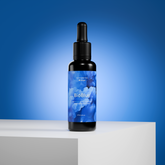Thyroid Health
How does RLT help?
Currently, red/NIR light therapy (RLT) is one of the only treatments that has the capability to potentially reverse, or at least mitigate progression of, autoimmune hypothyroidism.

Tell me more...
The thyroid gland is a butterfly shaped organ located in the lower front part of your neck. It is one of several glands comprising the endocrine system, and it secretes hormones responsible for regulating literally every cell, tissue, and organ in the body.
The thyroid gland normally releases many crucial hormones that travel through the bloodstream to reach receptors found throughout the body. So a disturbance in thyroid function can cause widespread, impactful health problems.
The thyroid gland is one of the most radiosensitive human organs. While it is well known that radiation exposure increases the risk of thyroid cancer, less is known about its effects in relation to nonmalignant thyroid diseases.
Hypothyroidism, commonly known as Hashimoto's hypothyroidism, is a condition in which the thyroid gland is underactive and doesn’t properly make or release thyroid hormones. Women — especially older women — are the most susceptible group for developing hypothyroidism.
Almost 5 percent of the U.S. population over the age of 12 has some form of hypothyroidism. Some estimates suggest up to 40 percent of the population suffers from at least some level of underactive thyroid.
What are some of the most common symptoms of hypothyroidism? Changes to your metabolism, heart function, digestion, energy, appetite, sleep or mood — even the growth of your hair, skin and nails can all be caused by hypothyroidism.
Scientific research has demonstrated powerful results of RLT for autoimmune hypothyroidism. Currently, RLT is one of the only treatments that has the capability to potentially reverse, or at least mitigate progression of, autoimmune hypothyroidism.

What does the research show?
“Our results are encouraging and PBM seems to be very effective in increasing T3/T4 ratio and decreasing TPO Ab levels (both positive metrics for thyroid health) and weekly dosages of LT4replacement therapy. Anti-inflammatory properties of PBM are greatly responsible for these changes and PBM causes major improvements in Hashimoto’s thyroiditis-related symptoms of the patient.” (1)
A 2013 RCT demonstrated that hypothyroid patients who received RLT had a dramatic improvement in their thyroid function and an immense reduction the thyroid antibody TPOAb. Shockingly, 47% of the patients were able to stop medication completely! (2)
A 2014 study with 347 women with subclinical hypothyroidism received 10 RLT sessions. At baseline, the average TSH (thyroid-stimulating hormone) was 9.1 mIU/L (higher TSH = hypothyroidism). The TSH normalized in 97% of the women in the study, with an average TSH of 2.2 mIU/L, after only ten RLT sessions. (3)
"We found that LLLT (low-level laser therapy) improved thyroid function, as measured by a reduction in the mean dose required for LT4 replacement therapy… Perhaps, using this approach at an early stage can reduce the incidence of overt hypothyroidism." (4)
"In summary, the results showed that LLLT (infrared laser) is safe when used for the treatment of patients with CAT (chronic autoimmune thyroiditis) without nodules in the parenchyma, as there was no increase in the frequency of nodular lesions. There was also no worsening of autoimmunity.” (5)
**While the current scientific research seems to indicate many positive benefits of RLT in relation to thyroid disorders, there is still an appreciable necessity for more extensive research to be conducted in this area, including double-blind RCT (randomized controlled trials), to provide a more comprehensive, robust overview that will further elucidate the optimal parameters and appropriate uses of RLT, which will ultimately lead the most safe and efficacious uses for individuals dealing with thyroid disorders.
Citations
(2) Höfling, Danilo & Cristina Chavantes, Maria & G Juliano, Adriana & Cerri, Giovanni & Knobel, Meyer & M Yoshimura, Elisabeth & Chammas, Maria. (2013). Low-level laser in the treatment of patients with hypothyroidism induced by chronic autoimmune thyroiditis: A randomized, placebo-controlled clinical trial. Lasers in medical science. 28. 10.1007/s10103-012-1129-9.
(3) Smelova I.V., Golovneva E.S. Study of morphological and functional changes in rat thyroid follicles under normal and hypothyroidism after exposure to medium-intense laser radiation. Bulletin of the Russian State Medical University. 2018; (3): 67–74. DOI: 10.24075 / vrgmu.2018.02
(4) Höfling, Danilo & Cristina Chavantes, Maria & G Juliano, Adriana & Cerri, Giovanni & Knobel, Meyer & M Yoshimura, Elisabeth & Chammas, Maria. (2012). Low-level laser in the treatment of patients with hypothyroidism induced by chronic autoimmune thyroiditis: A randomized, placebo-controlled clinical trial. Lasers in medical science. 28. 10.1007/s10103-012-1129-9.
(5) Höfling, Danilo & Cristina Chavantes, Maria & Buchpiguel, Carlos & Guido Cerri, Giovanni & Marui, Suemi & Campos Carneiro, Paulo & Chammas, Maria. (2018). Safety and Efficacy of Low-Level Laser Therapy in Autoimmune Thyroiditis: Long-Term Follow-Up Study. International Journal of Endocrinology. 2018. 1-9. 10.1155/2018/8387530.







